Aamir Shafi
NVIDIA Corporation
GPU-Initiated Networking for NCCL
Nov 19, 2025Abstract:Modern AI workloads, especially Mixture-of-Experts (MoE) architectures, increasingly demand low-latency, fine-grained GPU-to-GPU communication with device-side control. Traditional GPU communication follows a host-initiated model, where the CPU orchestrates all communication operations - a characteristic of the CUDA runtime. Although robust for collective operations, applications requiring tight integration of computation and communication can benefit from device-initiated communication that eliminates CPU coordination overhead. NCCL 2.28 introduces the Device API with three operation modes: Load/Store Accessible (LSA) for NVLink/PCIe, Multimem for NVLink SHARP, and GPU-Initiated Networking (GIN) for network RDMA. This paper presents the GIN architecture, design, semantics, and highlights its impact on MoE communication. GIN builds on a three-layer architecture: i) NCCL Core host-side APIs for device communicator setup and collective memory window registration; ii) Device-side APIs for remote memory operations callable from CUDA kernels; and iii) A network plugin architecture with dual semantics (GPUDirect Async Kernel-Initiated and Proxy) for broad hardware support. The GPUDirect Async Kernel-Initiated backend leverages DOCA GPUNetIO for direct GPU-to-NIC communication, while the Proxy backend provides equivalent functionality via lock-free GPU-to-CPU queues over standard RDMA networks. We demonstrate GIN's practicality through integration with DeepEP, an MoE communication library. Comprehensive benchmarking shows that GIN provides device-initiated communication within NCCL's unified runtime, combining low-latency operations with NCCL's collective algorithms and production infrastructure.
Scaling Large Language Model Training on Frontier with Low-Bandwidth Partitioning
Jan 08, 2025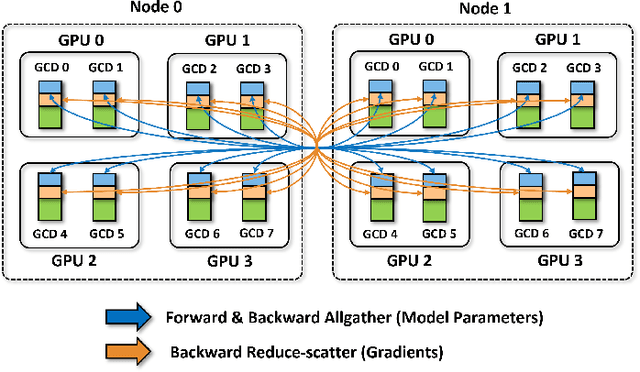
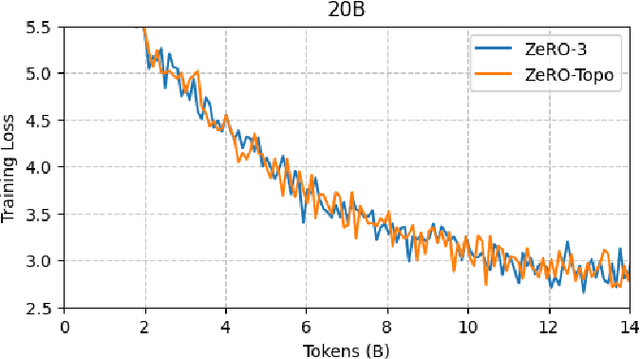
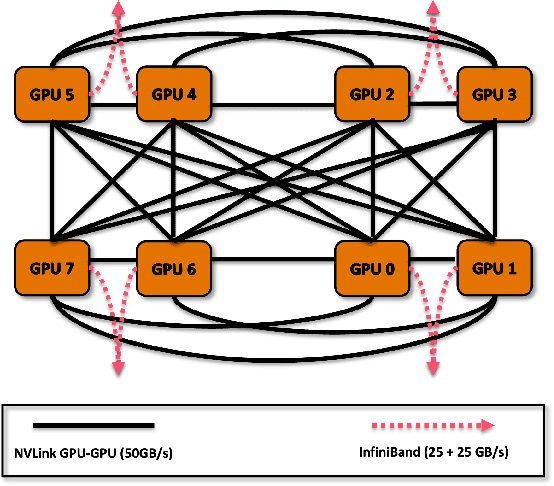
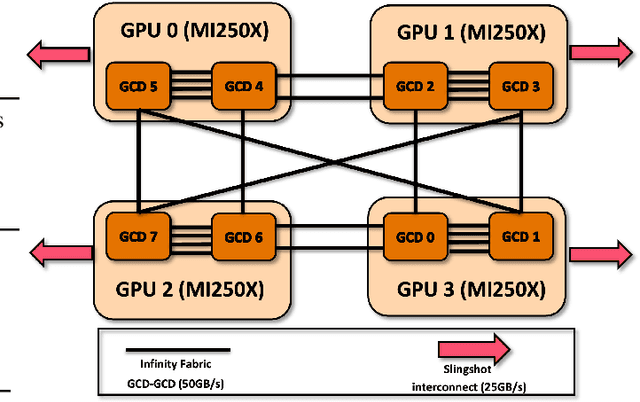
Abstract:Scaling up Large Language Model(LLM) training involves fitting a tremendous amount of training parameters across a limited number of workers. However, methods like ZeRO-3 that drastically reduce GPU memory pressure often incur heavy communication to ensure global synchronization and consistency. Established efforts such as ZeRO++ use secondary partitions to avoid inter-node communications, given that intra-node GPU-GPU transfer generally has more bandwidth and lower latency than inter-node connections. However, as more capable infrastructure like Frontier, equipped with AMD GPUs, emerged with impressive computing capability, there is a need for investigations on the hardware topology and to develop targeted strategies to improve training efficiency. In this work, we propose a collection of communication and optimization strategies for ZeRO++ to reduce communication costs and improve memory utilization. In this paper, we propose a 3-level hierarchical partitioning specifically for the current Top-1 supercomputing cluster, Frontier, which aims at leveraging various bandwidths across layers of communications (GCD-GCD, GPU-GPU, and inter-node) to reduce communication overhead. For a 20B GPT model, we observe a 1.71x increase in TFLOPS per GPU when compared with ZeRO++ up to 384 GCDs and a scaling efficiency of 0.94 for up to 384 GCDs. To the best of our knowledge, our work is also the first effort to efficiently optimize LLM workloads on Frontier AMD GPUs.
Accelerating Large Language Model Training with Hybrid GPU-based Compression
Sep 04, 2024
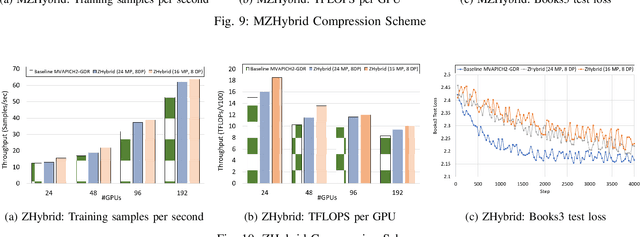
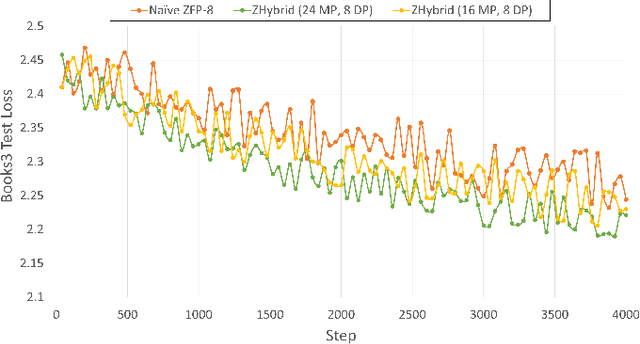
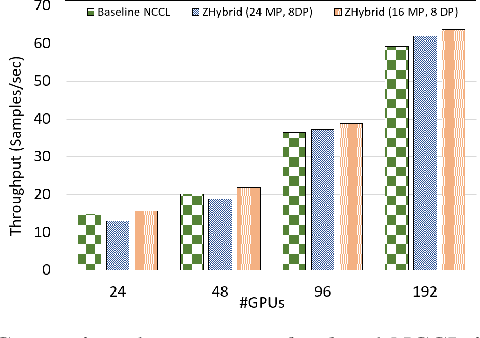
Abstract:Data Parallelism (DP), Tensor Parallelism (TP), and Pipeline Parallelism (PP) are the three strategies widely adopted to enable fast and efficient Large Language Model (LLM) training. However, these approaches rely on data-intensive communication routines to collect, aggregate, and re-distribute gradients, activations, and other important model information, which pose significant overhead. Co-designed with GPU-based compression libraries, MPI libraries have been proven to reduce message size significantly, and leverage interconnect bandwidth, thus increasing training efficiency while maintaining acceptable accuracy. In this work, we investigate the efficacy of compression-assisted MPI collectives under the context of distributed LLM training using 3D parallelism and ZeRO optimizations. We scaled up to 192 V100 GPUs on the Lassen supercomputer. First, we enabled a na\"ive compression scheme across all collectives and observed a 22.5\% increase in TFLOPS per GPU and a 23.6\% increase in samples per second for GPT-NeoX-20B training. Nonetheless, such a strategy ignores the sparsity discrepancy among messages communicated in each parallelism degree, thus introducing more errors and causing degradation in training loss. Therefore, we incorporated hybrid compression settings toward each parallel dimension and adjusted the compression intensity accordingly. Given their low-rank structure (arXiv:2301.02654), we apply aggressive compression on gradients when performing DP All-reduce. We adopt milder compression to preserve precision while communicating activations, optimizer states, and model parameters in TP and PP. Using the adjusted hybrid compression scheme, we demonstrate a 17.3\% increase in TFLOPS per GPU and a 12.7\% increase in samples per second while reaching baseline loss convergence.
Training Ultra Long Context Language Model with Fully Pipelined Distributed Transformer
Aug 30, 2024
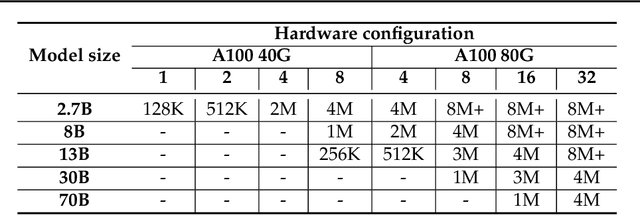
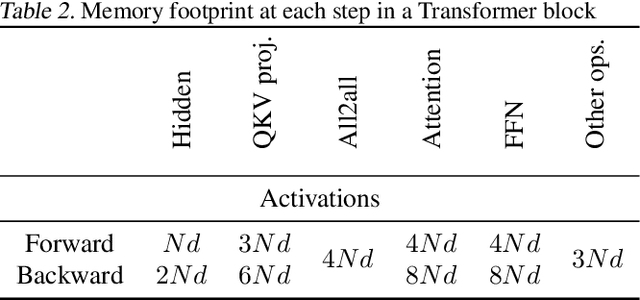

Abstract:Large Language Models (LLMs) with long context capabilities are integral to complex tasks in natural language processing and computational biology, such as text generation and protein sequence analysis. However, training LLMs directly on extremely long contexts demands considerable GPU resources and increased memory, leading to higher costs and greater complexity. Alternative approaches that introduce long context capabilities via downstream finetuning or adaptations impose significant design limitations. In this paper, we propose Fully Pipelined Distributed Transformer (FPDT) for efficiently training long-context LLMs with extreme hardware efficiency. For GPT and Llama models, we achieve a 16x increase in sequence length that can be trained on the same hardware compared to current state-of-the-art solutions. With our dedicated sequence chunk pipeline design, we can now train 8B LLM with 2 million sequence length on only 4 GPUs, while also maintaining over 55% of MFU. Our proposed FPDT is agnostic to existing training techniques and is proven to work efficiently across different LLM models.
Demystifying the Communication Characteristics for Distributed Transformer Models
Aug 19, 2024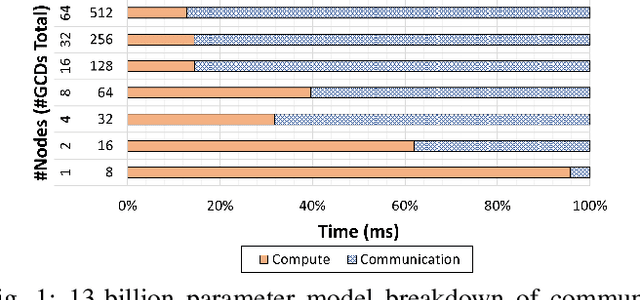



Abstract:Deep learning (DL) models based on the transformer architecture have revolutionized many DL applications such as large language models (LLMs), vision transformers, audio generation, and time series prediction. Much of this progress has been fueled by distributed training, yet distributed communication remains a substantial bottleneck to training progress. This paper examines the communication behavior of transformer models - that is, how different parallelism schemes used in multi-node/multi-GPU DL Training communicate data in the context of transformers. We use GPT-based language models as a case study of the transformer architecture due to their ubiquity. We validate the empirical results obtained from our communication logs using analytical models. At a high level, our analysis reveals a need to optimize small message point-to-point communication further, correlations between sequence length, per-GPU throughput, model size, and optimizations used, and where to potentially guide further optimizations in framework and HPC middleware design and optimization.
The Case for Co-Designing Model Architectures with Hardware
Jan 30, 2024



Abstract:While GPUs are responsible for training the vast majority of state-of-the-art deep learning models, the implications of their architecture are often overlooked when designing new deep learning (DL) models. As a consequence, modifying a DL model to be more amenable to the target hardware can significantly improve the runtime performance of DL training and inference. In this paper, we provide a set of guidelines for users to maximize the runtime performance of their transformer models. These guidelines have been created by carefully considering the impact of various model hyperparameters controlling model shape on the efficiency of the underlying computation kernels executed on the GPU. We find the throughput of models with efficient model shapes is up to 39\% higher while preserving accuracy compared to models with a similar number of parameters but with unoptimized shapes.
Exploiting Inter-Layer Expert Affinity for Accelerating Mixture-of-Experts Model Inference
Jan 17, 2024



Abstract:In large language models like the Generative Pre-trained Transformer, the Mixture of Experts paradigm has emerged as a powerful technique for enhancing model expressiveness and accuracy. However, deploying GPT MoE models for parallel inference on distributed systems presents significant challenges, primarily due to the extensive Alltoall communication required for expert routing and aggregation. This communication bottleneck exacerbates the already complex computational landscape, hindering the efficient utilization of high-performance computing resources. In this paper, we propose a lightweight optimization technique called ExFlow, to largely accelerate the inference of these MoE models. We take a new perspective on alleviating the communication overhead by exploiting the inter-layer expert affinity. Unlike previous methods, our solution can be directly applied to pre-trained MoE models without any fine-tuning or accuracy degradation. By proposing a context-coherent expert parallelism on distributed systems, our design only uses one Alltoall communication to deliver the same functionality while previous methods all require two Alltoalls. By carefully examining the conditional probability in tokens' routing across multiple layers, we proved that pre-trained GPT MoE models implicitly exhibit a strong inter-layer expert affinity. We then design an efficient integer programming model to capture such features and show that by properly placing the experts on corresponding GPUs, we can reduce up to 67% cross-GPU routing latency. Our solution beats the cutting-edge MoE implementations with experts from 8 to 64, with up to 2.2x improvement in inference throughput. We further provide a detailed study of how the model implicitly acquires this expert affinity at the very early training stage and how this affinity evolves and stabilizes during training.
Flover: A Temporal Fusion Framework for Efficient Autoregressive Model Parallel Inference
May 24, 2023



Abstract:In the rapidly evolving field of deep learning, the performance of model inference has become a pivotal aspect as models become more complex and are deployed in diverse applications. Among these, autoregressive models stand out due to their state-of-the-art performance in numerous generative tasks. These models, by design, harness a temporal dependency structure, where the current token's probability distribution is conditioned on preceding tokens. This inherently sequential characteristic, however, adheres to the Markov Chain assumption and lacks temporal parallelism, which poses unique challenges. Particularly in industrial contexts where inference requests, following a Poisson time distribution, necessitate diverse response lengths, this absence of parallelism is more profound. Existing solutions, such as dynamic batching and concurrent model instances, nevertheless, come with severe overheads and a lack of flexibility, these coarse-grained methods fall short of achieving optimal latency and throughput. To address these shortcomings, we propose Flavor -- a temporal fusion framework for efficient inference in autoregressive models, eliminating the need for heuristic settings and applies to a wide range of inference scenarios. By providing more fine-grained parallelism on the temporality of requests and employing an efficient memory shuffle algorithm, Flover achieves up to 11x faster inference on GPT models compared to the cutting-edge solutions provided by NVIDIA Triton FasterTransformer. Crucially, by leveraging the advanced tensor parallel technique, Flover proves efficacious across diverse computational landscapes, from single-GPU setups to multi-node scenarios, thereby offering robust performance optimization that transcends hardware boundaries.
MCR-DL: Mix-and-Match Communication Runtime for Deep Learning
Mar 15, 2023



Abstract:In recent years, the training requirements of many state-of-the-art Deep Learning (DL) models have scaled beyond the compute and memory capabilities of a single processor, and necessitated distribution among processors. Training such massive models necessitates advanced parallelism strategies to maintain efficiency. However, such distributed DL parallelism strategies require a varied mixture of collective and point-to-point communication operations across a broad range of message sizes and scales. Examples of models using advanced parallelism strategies include Deep Learning Recommendation Models (DLRM) and Mixture-of-Experts (MoE). Communication libraries' performance varies wildly across different communication operations, scales, and message sizes. We propose MCR-DL: an extensible DL communication framework that supports all point-to-point and collective operations while enabling users to dynamically mix-and-match communication backends for a given operation without deadlocks. MCR-DL also comes packaged with a tuning suite for dynamically selecting the best communication backend for a given input tensor. We select DeepSpeed-MoE and DLRM as candidate DL models and demonstrate a 31% improvement in DS-MoE throughput on 256 V100 GPUs on the Lassen HPC system. Further, we achieve a 20% throughput improvement in a dense Megatron-DeepSpeed model and a 25% throughput improvement in DLRM on 32 A100 GPUs with the Theta-GPU HPC system.
Performance Characterization of using Quantization for DNN Inference on Edge Devices: Extended Version
Mar 09, 2023



Abstract:Quantization is a popular technique used in Deep Neural Networks (DNN) inference to reduce the size of models and improve the overall numerical performance by exploiting native hardware. This paper attempts to conduct an elaborate performance characterization of the benefits of using quantization techniques -- mainly FP16/INT8 variants with static and dynamic schemes -- using the MLPerf Edge Inference benchmarking methodology. The study is conducted on Intel x86 processors and Raspberry Pi device with ARM processor. The paper uses a number of DNN inference frameworks, including OpenVINO (for Intel CPUs only), TensorFlow Lite (TFLite), ONNX, and PyTorch with MobileNetV2, VGG-19, and DenseNet-121. The single-stream, multi-stream, and offline scenarios of the MLPerf Edge Inference benchmarks are used for measuring latency and throughput in our experiments. Our evaluation reveals that OpenVINO and TFLite are the most optimized frameworks for Intel CPUs and Raspberry Pi device, respectively. We observe no loss in accuracy except for the static quantization techniques. We also observed the benefits of using quantization for these optimized frameworks. For example, INT8-based quantized models deliver $3.3\times$ and $4\times$ better performance over FP32 using OpenVINO on Intel CPU and TFLite on Raspberry Pi device, respectively, for the MLPerf offline scenario. To the best of our knowledge, this paper is the first one that presents a unique characterization study characterizing the impact of quantization for a range of DNN inference frameworks -- including OpenVINO, TFLite, PyTorch, and ONNX -- on Intel x86 processors and Raspberry Pi device with ARM processor using the MLPerf Edge Inference benchmark methodology.
 Add to Chrome
Add to Chrome Add to Firefox
Add to Firefox Add to Edge
Add to Edge